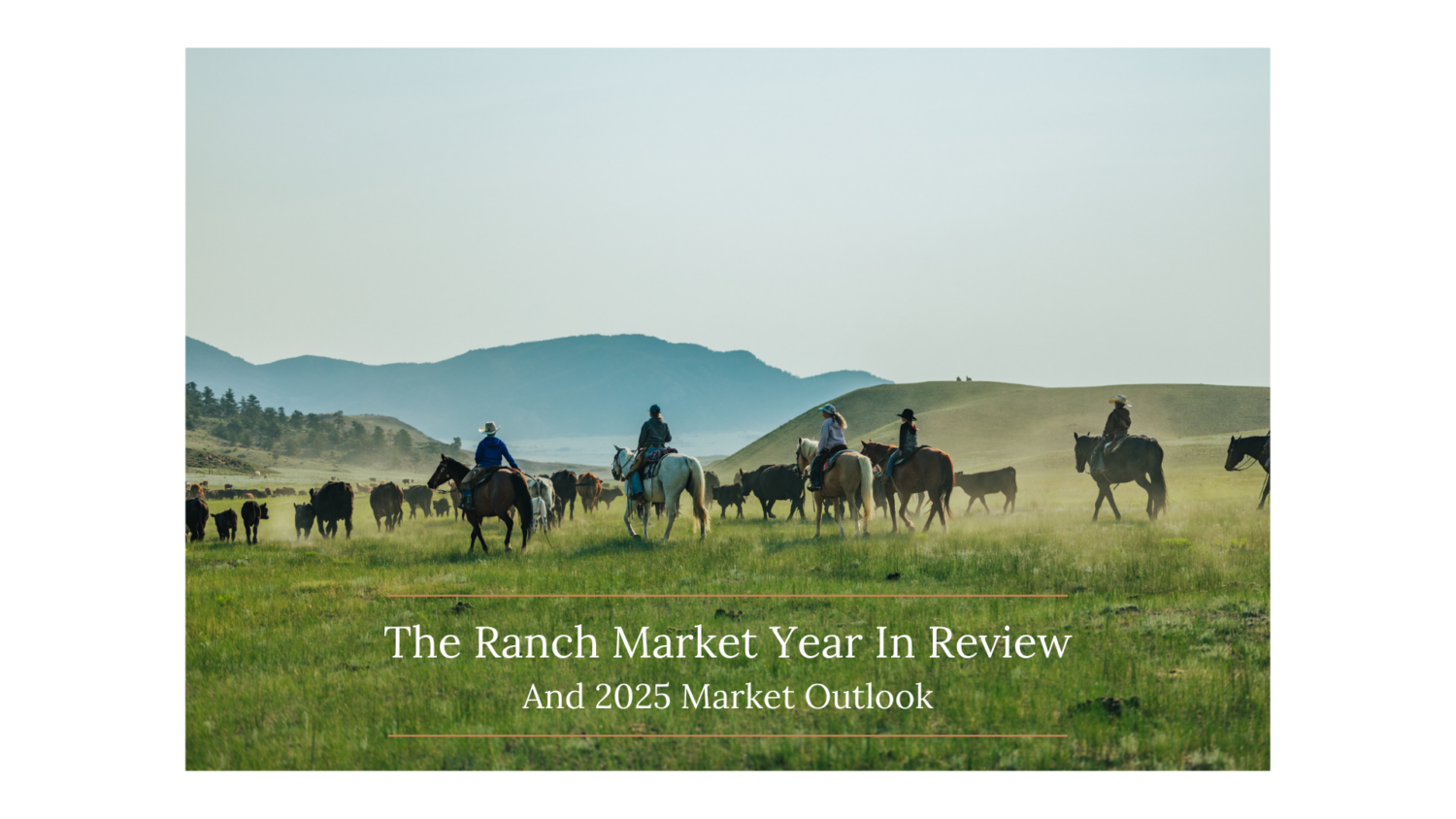January 2025 Field Note: 2024 Ranch Market Year in Review

The beginning of a new year offers a moment to assess the factors that influenced the Western land market in 2024, and to consider how these dynamics shaped land transactions throughout the year. For landowners and prospective buyers, it’s wise to take stock of market trends that have impacted sales and investments, while also considering how these trends will evolve in the year ahead. With 2025 promising major economic and legislative changes, the new year brings with it a chance to recalibrate strategies, stay informed on emerging trends, and position oneself for success in an ever-changing market.
While we eagerly await the statistics to be compiled on 2024, we recently sat down with Confluence Land Company Founding Partner and Managing Broker Michael Ledger to hear his anecdotal account of the 2024 Western land market and learn where markets are likely headed in 2025.
1. To begin with some context, what was the ranch market dynamic entering 2024? What factors shaped the lead-up into the last year’s sales season?
While peak values were reached in 2022, land values in 2023 remained relatively steady due to limited supply. Transactional volume decreased. It’s safe to say that activity moderated compared to the previous blue hot two years. Landowners were motivated to hold and buyers faced supply shortages. The appetite for purchasing ranches remained entering 2024; it was just a little tougher to transact.
2. How did the 2024 season play out? Did the market align with your expectations coming into the year?
Here are the predictions from our 2023 Year-End Report: Confluence Land Company predicts another year of limited supply and stabilized values. Though the market will be quick to dismiss overpriced ranches, this remains a superb market to sell into if sellers have a plan for their proceeds. 2024 will reward buyers who are prepared to transact quickly and sellers who are priced appropriately. Unlike the blue hot markets of 2021 and 2022, well-developed and well-timed marketing will have significant impact on how long ranches take to transact once listed for sale. Like 2023, competition for large, investment grade ranges in 2024 will not only be other large, investment grade ranches but also non-land assets like bonds and treasury bills, though we expect the latter to wane towards the end of the year.
In short, the 2024 market played out exactly how we forecasted. Humility forces me to acknowledge that our forecast is only year in advance as opposed to forecasts greater in length. However, our constant monitoring of the market across multiple deal sizes in the mountain west allows us to have a real time understanding of the market dynamics.
3. What type of ranch offerings and amenities attracted outsized buyer interest in 2024?
We migrated back to outsized interest in ranches with the core desirable characteristics: a good location, moderate valued (as opposed to outlandish) modern vertical improvements, limited deferred maintenance, and other high-scoring core amenities such as prime hunting land with direct public land borders or ranches with unencumbered live-water resources.

4. From an investment standpoint, how did rural land stack up against other investment opportunities last year? What seems to be the general sentiment of investors holding/ transacting rural real estate assets?
This was a critical aspect of the 2024 market. Rural land outperformed a significant other amount of real property asset classes. At the bottom were asset classes such as income-producing office buildings, and in the middle were assets like Class-A industrial buildings and primary residences. Quality rural land led these other asset classes by a significant margin. This is largely because inflation was still a big storyline in 2024, and investors were still seeking to hedge with rural land. We still have some of that happening now. This dynamic can keep some landowners tied to their land assets until there is a solid financial case to be made for investing in other asset classes.
5. The 2025 economic landscape looks a lot different than 2024, and Confluence Land Company has already seen positive land market trends post-election. How would you describe the 2025 land market outlook?
This may seem a little biased considering we profit from being engaged to sell land, but the reality is that correctly pricing and marketing rural land assets in 2025 is going to be critical for sellers, because we forecast an uptick in supply. It will by no means be a firm buyer’s market, but there may be more opportunity for buyers this year. Sellers will be required to act reasonably in their pricing strategies, and marketing effectively will be absolutely critical. Finding a deal with every bonafide, interested buyer will be more important as well. I would be remiss if I didn’t mention the election. From a rural land performance standpoint, it has and will continue to have only a nominal impact to the market in our estimation. Frankly, it was priced into the 2024 market. For the most part, the markets knew what they would be in for under either prospective administration. That gave the market an opportunity to brace and plan.
6. What can landowners, prospective buyers, or anyone interested in Western land markets do to learn more about last year’s market dynamics and upcoming forecasts for 2025?
Every Confluence Land Company broker loves discussing market dynamics, so please don’t hesitate to call any one of us directly. Engaging with rural land on a daily basis allows us to offer tailored insights whether you’re considering selling, buying, or simply want to increase your familiarity with the ranch market. We also encourage you to monitor the market on a deal-by-deal basis; you can do that by subscribing to our newsletters and watching our activity. In late winter, our full statistical analysis of the 2024 Ranch Market will be distributed through our emails and other outreach.

